Reporting for this story was supported by a media fellowship grant from The Bill Lane Center for the American West at Stanford University.
By Elizabeth Zach, RCAC staff writer
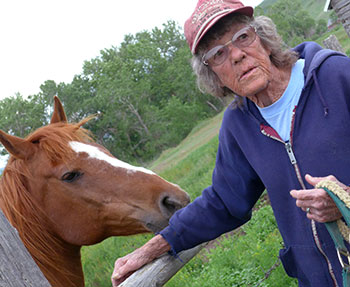
The story of Donna Schroeder’s life until now—she is 76—can be told with chicken scratches carved into a small wooden block, an engraving that hangs amid dozens of others just like it in Elmo’s Highwood Bar in Highwood, Montana. This is where Donna sits one afternoon at the counter eating a BLT and chips.
The engraving, this stick-figure scrawl, is the cattle brand she and her husband once owned. But next to it is another, which signifies an unmistakable shift, mirroring what must have been at the time a momentous decision. It’s the current brand, which is a simple D and S, Donna’s alone. And when Donna stands alongside it in her jeans, boots and chaps, you sense that the pride remains these many years later. When you ask Donna about her husband’s passing when she was just 38, and observe that she was still young and might have remarried, she says with resolution, “I’ll try anything once.”
He drank. They argued. After he died, she raised their two children until both eventually moved to the city for work.
Donna and her husband had worked alongside one another for decades, hustling cattle across hundreds of acres, back-breaking work that doesn’t ease no matter how many people are helping you.
She is wizened and weathered, with callused hands and a deliberate, cautious walk. She still does the cattle drives and typically has between 340 and 350 head, which on the face of it feels overwhelming. But Donna dismisses it, saying, “The labor ain’t nothing like what my grandmother had to endure.”
Modesty aside, Donna is a striking example of an intriguing and expansive demographic in America today. According to the Economic Research Service, a U.S. Department of Agriculture agency, in the past three decades the number of women-operated farms has increased substantially in the nation. Between 1978 and 2007, when the last agriculture census was completed, the number of women-operated farms in the U.S. grew from 306,200 to nearly a million. Women run 13 percent of all the nation’s farms and are 30 percent of all farmers in the U.S.
The numbers have spurred USDA to look more closely at these women to try and better understand their inspiration and circumstances. The agency’s motivation pivots on its concern with national food security, as well as farm transitions, or who will take over the land when farmers today are too old to work it.
“I rope, ride and build fence. It’s what I do. It’s my job.”
—Laura Jean Schneider, New Mexico
In the popular imagination these women’s lives and work are a curious turn on the idea of rugged individualism. Writer Lori Rotenberk noted in a June 2013 column in the online magazine Grist, that many of these women “are 40 and older, leaving behind office jobs and careers for the opportunity to get their hands dirty and create something tangible. At the other end of the spectrum are younger women who are coming out of agricultural and environmental science programs with a dedication to food justice, education and reminding a nation led astray by fast food and TV dinners where its sustenance really comes from. There is also an older generation of women who have outlived their husbands and now own vast amounts of farm and ranchland. Combined, they are making new inroads for women who are determined to build a life around farming.”
But to Donna, none of this seems to matter much. There’s work to be done, and she quietly goes about it daily. Never mind the fact that in 2000 she was inducted into the National Cowboy Hall of Fame, joining the ranks of only a handful of women who possess such bragging rights.
But on a sobering note she acknowledges there is very little profit margin in the work. There is, rather, bank debt and relentless upkeep of machinery. It takes a formidable character to take on a ranch these days, and preferably one with a lot of cash.
“I have the land,” she says. “If someone wants to do ranching these days, basically someone has to get out so you can get in. There’s only so much land to go around.”
Women like Donna are the changing face of agricultural work in the U.S. In the rural West, these women raise cattle, sheep, poultry, pigs and goats, and are ever mindful of the worsening drought. They grow Malbec and Pinot Noir grapes in California, Washington and Oregon. They farm lavender, peppermint, melons, and seemingly every other delicacy under the sun. They make cheese from goat and sheep’s milk, and they sell their wares at farmers’ markets, community supported agriculture co-ops or online. Some have taken on teaching roles, and find that more and more women like themselves are entering the field. Many see themselves less as entrepreneurs and far more as gentle stewards of the land, quiet bulwarks against corporations overtaking family farms or developers sweeping in with irresistible offers.
“I think the presence of women operators is so important because the way we do things now – big land, big machinery, few people – may seem like the only thing that makes sense but it just isn’t sustainable, which means that at some point it will change radically or else crumble,” says Laurie Wayne, who runs Locavore Farms near Fort Bidwell, California. “Farming teaches people that things are more complex and at the same time more accessible, and absolutely non-negotiable. It’s such a gift for me to work in a gentle, generous world where what I want doesn’t much matter.”
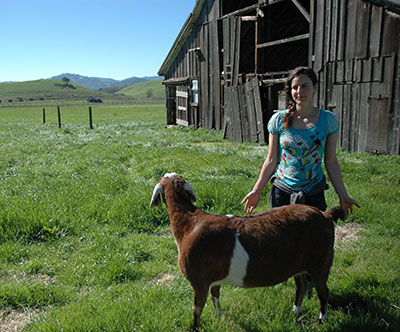
Some women see ranching in terms of caring for children.
“You need patience, and you need to understand that an animal needs space around it in order to feel comfortable,” says Alissa Donovan, who ranches in Utah. “I never yell at them. I establish a rapport, and keep it all very low stress. I used to teach preschool, so I’m used to herding.”
Clearly, anyone working in agriculture can’t be intimidated by the work. For Annie Hehner, who is 29 years old and farms in California’s Capay Valley, 18-hour days—particularly in the summer heat—are the norm. She recently hired a male friend to help her fix a tractor.
“The key to not going under with all of this is hard work,” she says as she walks among rows of recently planted tomato vines and pepper plants. “You have to be willing to live simply.”
While these women have much in common, their differences are also striking. Some inherited the land they work, while others are keen to own their farms or ranches. Land prices, however, particularly in California, are prohibitive.
“Since California is in drought, and will be for we don’t know how long, I’ve thought about doing something like drought-resistant landscaping,” says Anna Ruth Crittenden, 24, a participant in the nine-month long training program at the Center for Land-Based Learning near Winters, California. While she dreams of having her own farm someday, land in the Golden State is out of reach for now. “So I’ve coined a term for what I might be doing in the future: farden, a combination of farming and gardening.”
USDA has noted that women tend to own the land they work, whereas men more often lease. Researchers are unsure why, though it may be that women take on smaller parcels – or else downsize when they inherit – which makes the work more affordable and manageable. Some studies point to farming’s mechanization, making it easier for a woman to farm and ranch on her own.
Lilian Ma, who in early 2015 bought 72 acres in the California Delta to farm peppermint for her father’s herbal business in the San Francisco Bay Area, says she sees no other way for herself to work as a farmer except as a single woman. By age 29, she had worked on farms in New Zealand, Indonesia, Australia and China. Like Anna Ruth, she studied at the Center for Land-Based Learning.
Looking out at the land, she describes the work ahead: fencing needs to be put up, more native trees should be planted—they help block the strong winds that can blow through the Delta—and she would like to eventually be certified as an organic grower, so there will be reams of paperwork for that. But she is eager for it all.
“I really wanted to build this all myself,” she says. “I may have a partner at some point, but I want any mistakes made here to be my own. If this ship sinks, I want only my fingerprints on it.”
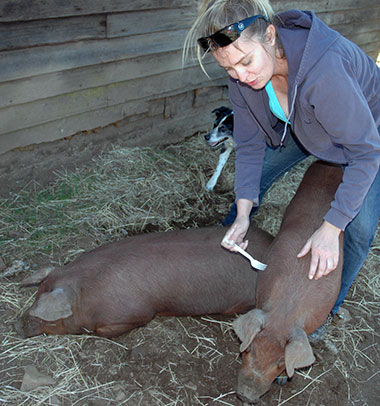
The same refrain can be heard 100 miles northward, in Oroville, California, where Megan Brown has made a name for herself raising Red Wattle pigs on her parents’ 3,000-acre ranch. With close to 5,000 Twitter followers, she waxes about the freedom her work offers her, and her belief in better transparency in the agriculture industry, including inviting meat customers to watch slaughtering. She visits restaurants that buy her meat and speaks at agriculture conventions where she advocates for more women to enter the ranching profession.
“My dad has my entire wedding already planned out,” she says, with a rolling of the eyes. “But no one’s convinced me yet that marriage is a good idea. I tell my dad, ‘Hey, I grow things. I got a tractor. I can lift heavy things myself with it.’”
On the Mescalero Apache reservation in northern New Mexico, where Laura Jean Schneider, age 31, and her husband are setting up a ranching operation, it helps, she says to have a partner, though she quickly adds, “I rope, ride and build fence. It’s what I do. It’s my job.” It’s a remarkable dedication when one considers that Laura Jean survived a violent car accident in 2003 and still suffers from debilitating migraines and back pain.
A common observation about modern rural America is that younger people, either out of necessity or ambition, are leaving for the cities. This is one more reason that the USDA and the Economic Research Service have dedicated time and resources toward better understanding whether farmers and ranchers have succession plans in place.
“It’s a big issue in agriculture, this idea of ‘farm transition,’ or the process of passing the farm to the next generation,” says James Williamson, an economist with the Economic Research Service. “We’ve started asking farmers if they have a plan for the farm’s future, whether they have someone designated to assume the operation.”
Brenda Frketich runs a farm near Salem, Oregon, which has been in her family for four generations. She tells how her grandfather worked the land and her grandmother prepared mid-day snacks, lunch and dinner for the hired hands. She pulls out a weathered ledger book and admires her grandmother’s tidy penmanship and meticulous notes and figures, testament to the dedication and ties to the land. Brenda herself earned a business degree before taking over the farm when her father decided to retire a few years ago.
“You can learn the dirt, learn the soil, you can learn the tools, but you need to understand the business,” she says. “I run stuff by my father, but he lets me, and wants me to, make decisions on my own.”
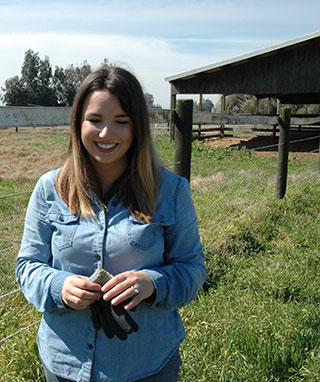
Similarly, in California’s Central Valley, Anjelika Locke speaks proudly of her Azorean roots and what they can teach her as she looks to expand her organic chicken farm.
“I’ve seen small goat dairies and organic soap-making operations run by women,” she says. “I’ve watched rotational grazing—all of this stuff has been practiced in the past, long ago, but we’ve moved away from it. There are good lessons to be learned from what our grandparents did.”
This same reverence for history and historical practices can be heard when Ruthie King speaks of her interest in California’s Grange. As a co-founder of The Farm School in Willits, California, Ruthie says that more and more of her students are young women—and that this is something the Grange, when it was founded in 1867, encouraged even back then.
“At first, it was a secret society, a political and populist movement composed of members opposed to the railroad monopolies,” she explains. “There were ritual traditions, a secret handshake and democratic votes on issues of the day. But there was also, amazingly, suffrage for women within the Grange, and the organization had three goddesses on its logo: Pomona (the goddess of fruit), Ceres (the goddess of grain) and Flora (the goddess of flowers).”
Nostalgia notwithstanding, older women working in agriculture in the American West say that anyone entering the business today has to be on-the-ball, forever on the look-out for opportunities to improve their business acumen.
Cheryl Cosner, who together with her husband runs the Upper Dry Creek Ranch near Weston, Oregon, spends her evenings answering emails from customers and designing marketing brochures. At age 52, petite and fit, she oversees their sheep and cattle ranching business, which has become one of the premier lamb distributors in the Pacific Northwest. She recalls how, starting out in southern Oregon, her husband’s farming family didn’t quite know what to make of her drive to play an essential role in the business.
“The women in his family didn’t work the land,” she says. “They kept house and the farm’s books, but the grueling physical labor was left to the men. What I saw, though, when I was young … I didn’t drive a tractor, but this was a dairy community and the women basically ran the place. I didn’t see the restrictions. I saw opportunity.”
And she loves the hard labor.
“I basically feel icky sitting behind a computer. I love horse-riding,” she says. “Ranching gives me an excuse to be on a horse. I love the complexity of the ranching eco-system. It’s never boring.”
Cheryl studied agriculture in college, minoring in agricultural economics at a time when, she estimates, about only 30 percent of her fellow students were female. She has observed, however, how women’s roles on farms and ranches have evolved.
“It used to be that they fell into one of three categories,” she says. “You were either married to a farmer or rancher and picked up the business tangentially; or you were a helpmate, tending to the family, trucking grain, bookkeeping or gathering livestock. Or else you were a real partner to your farming husband, by which I mean that you took this on as a career choice.” She says that while those three categories still exist, women today have far more freedom to be helpmates or even equal partners to their farmer or rancher husbands and to completely and independently take the reins of a farming operation.
“A lot of men in the business just weren’t used to talking with a woman about, oh, say, bulls and testicles. … I once had a rancher come to my door about something and he asked me, ‘Are your parents home?’”
—Cheryl Cosner, Oregon
At one point, Cheryl taught farming economics and business administration in China. She also took art classes which, she says, came in handy later as she started marketing her farm products. The work appears daunting—lambing and calving can go on for up to a month—she now has 390 ewes and has been steadily increasing the number by about 35 per year. Nevertheless, she found that her skills and experience in farming, and the business and advertising of it, still laid her open to discrimination.
“A lot of men in the business just weren’t used to talking with a woman about, oh, say, bulls and testicles,” she recalls. “I once had a rancher come to my door about something and he asked me, ‘Are your parents home?’”
It would seem that Bernie Barlow, who ranched with her husband for more than 30 years an hour’s drive from Gillette, Wyoming, would have encountered this same discrimination when she arrived newly married at his parents’ ranch in 1963. Her husband had met her barely a year prior in Cambodia, where he was a student volunteer helping native farmers improve their operations. Bernie, whose parents were French citizens, has the dark skin of her Indian father and a French accent.
“My husband’s parents didn’t accept me at first,” she recalls. “It took time. But I was used to this, actually, because my parents were pioneers in Asia, you could say. But over time around here, everyone, absolutely everyone, in this community welcomed me.”
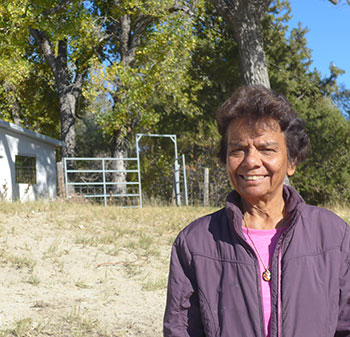
She did everything at the 18,000-acre ranch, alongside her husband—“I built fences, wells, I rode horses, I eventually managed the finances… It was a true partnership”—and has nothing but admiration for her husband’s hard work and commitment to the land. She describes how, in the early 1970s, when coal companies discovered deposits beneath the nearby Powder River, the Barlow family watched with alarm as strip mines and coal-fired power plants opened across the landscape. In 1973, her husband founded the Powder River Basin Resource Council, pressing for legislation to protect water quality and to regulate compensation to communities affected by industrial development.
Her husband died suddenly of an aneurysm in 2000. Her children and friends assumed she would immediately sell the ranch, but she didn’t. Instead, she expanded operations, including offering to act as a guide for hunters visiting the area. But two years ago, for whatever reason, the isolation started to wear on her.
“The roads here get bad in the winter, and I was starting to miss something social,” she says. “I realized this isn’t much of a life anymore for me.” She then made the difficult decision to put the ranch up for sale and to move to Sheridan, which she says has a thriving culture scene and is a magnet for retirees.
For Sherry Haugen, such a decision feels far off, though she is familiar with the social isolation Bernie describes. After a bitter divorce, she fled to the middle of nowhere, specifically a neglected alfalfa field skirting the remote border around Colorado’s San Luis Valley. This is dry, barren country, but for Sherry, it is also her beloved home and where she operates her Mountain Grown Lamb & Pelts.
Looking back, she says it’s been a hardscrabble climb to stability. She describes the diligence and smarts a woman—or, really, anyone—needs to apply for Farm Service Agency (FSA) grants and loans. The agency offers these funds to beginning farmers and ranchers to purchase livestock, equipment, feed, seed, and supplies and to construct buildings or make farm improvements. Sherry now sits on the local chapter’s board. When talk turns to younger women farming and ranching, she considers her own land and the fact that neither her son nor daughter has interest in taking over the operations.
“But someone will take over,” she says, “if not my children, then another young person, maybe even a young woman.”
She may have someone like Megan Brown, the Oroville farmer, in mind. During a recent tour of her operation, she pointed to a well and solar panels, all funded, she said, by a beginning farmer grant which, she adds, she clandestinely applied for knowing that her father, who is also a farmer, would initially disapprove.
“He couldn’t believe it,” she said. “He doesn’t trust the USDA. I told him they came to the rescue for me. He seemed to understand that.”
Sherry, too, sees value in whatever it takes to keep a woman financially independent on her own land. She practically glows when speaking of her business, and also the gratitude she has for her solitary life on the open range. She happily imagines someday traveling to southern France and northern Spain to witness the sheepherding genius of the Basque people.
“They have it down to a science and I’d love to go there and see it for myself,” she says.
Her quiet, contented life in this remote pastoral corner of Colorado makes her, in a sense, a distant soil sister to Donna Schroeder, more than a thousand miles away in Montana. Both speak of the incomparable freedom and seclusion; how each animal they tend feels at times like a child.
“I know them all by heart. I raised them,” Sherry says, adding what it feels like during calving season, the long, silent nights, when she looks up to the endless heavens when, she says, you can see the Milky Way.
Similarly, Michaele Blakely, who farms near Carnation, Washington, vividly describes the intimate connection she feels to the land, and the sorrow that comes when you can’t tend to it.
It was one winter and the rivers near her farmland were flooding. She and neighbors set about placing sand bags around the area and while doing so, she injured her hand. She couldn’t work for six weeks. This was years ago, she recalled recently, but the memory is still clear.
More so, however, is the longing to return to the land. It was, she says, “like a bone-deep ache, worse even than when my husband died.”
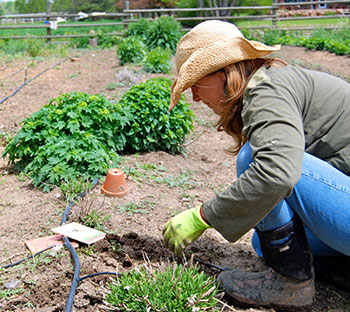
Likewise, Rosemary Graff, whose 7.5-acre farm near Fort Collins, Colorado, serves as a hub for the rural community where she lives, a modern-day commons where families bring their children to connect them to the seasons and where their food comes from. This wish to tether themselves to the earth, and also to draw others to it, has drawn many farming and ranching women today to their work, in spite of the financial and physical challenges.
“When I have children out here, I explain that the first pig I own is to eat, the second pays for the first and the third is for profit,” she says. “I want them to understand that the animals are being raised for the dinner table, and when they have to say goodbye to one, they get it, on a very basic level; they see the relationship. When we have a fox attack, they get it. When there’s a hail storm, they understand that that can kill crops. We need to get back to that understanding, and I think that women can do that in a crucial, meaningful way.”
Photos included in this article were taken by Elizabeth Zach. The homepage call-out photo was taken by Mamen Suara.
